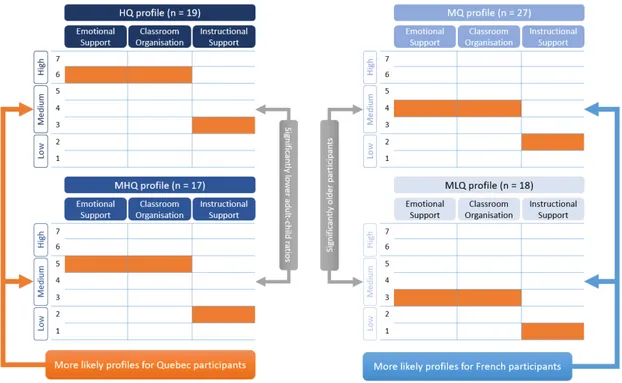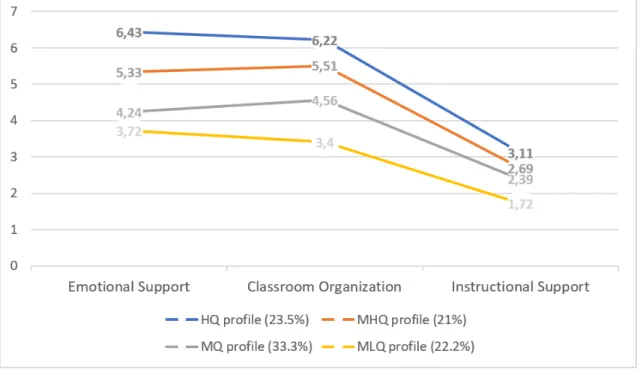Profiles of teacher-child interaction quality in
groups of three-year-old children in Quebec and
France
Maude Roy-Vallières, Nathalie Bigras, Annie Charron, Caroline Bouchard, Andréanne
Gagné and Philippe Dessus
Université du Québec à Montréal, Université Laval, Université Grenoble Alpes
QUALITY EXPERIENCES IN EARLY CHILDHOOD, A
NECESSITY
Awareness about the necessity of quality experiences in early childhood has risen in the recent years. A United Nations’ goal for sustainable development in 2030 is to ensure quality preschool education for all children (United Nations, 2020). During the early years, the high plasticity of the brain allows for experiences to modify the child’s neural connections (Simard et al. 2013; Yoshikawa et al. 2013). Hence the brain structure is transformed permanently, which alters children’s developmental trajectory and chances for school success.
Source : https://www.hippopx.com/en/children-school-fun-pool-balls-enjoying-colors-child-133995 (https://www.hippopx.com/en/children-school-fun-pool-balls-enjoying-colors-child-133995)
High quality educational environments offer stimulating experiences adapted to the child’s developmental needs. Conversely, low-quality educational contexts provide few stimulation opportunities and may exacerbate developmental delays and learning difficulties (Laurin et al. 2015; Waldfogel et al. 2002). There is a need to ensure high quality preschool services around the globe, which has led some jurisdictions to implement quality assessment practices (OCDE, 2015).
What exactly is educational quality?
While there are different approaches to defining educational quality, a popular view is that quality is comprised of two main dimensions, namely structural quality and process quality (Bigras et al. 2010; Slot 2018).
Figure 1. Dimensions of educational quality
Structural Quality refers mostly to regulated aspects of the educational environment that impact adults’ work, such as group size, adult-child ratio and staff initial and ongoing training (Bigras et al. 2010; Ruopp 1979).
Process quality encompasses components that interact directly with the child and influences his experiences. Recently, researchers have mostly been concerned with interaction quality, and more specifically adult-child interactions (Melhuish et al. 2015).
REVISITING BIGRAS ET AL.'S STUDY
It is however important to consider that values and cultural beliefs have a role to play in determining what are quality educational services. For example, while Quebec and France share significant similarities, studies have shown that they favor different educational approaches (Anders 2015; Tazouti et al. 2011), leading to possible discrepancies in observed quality.
Source : https://pixabay.com/illustrations/arrow-directory-signposts-direction-2085192/ (https://pixabay.com/illustrations/arrow-directory-signposts-direction-2085192/)
To investigate this possibility, Bigras et al. (In press) conducted a comparative study in 2017-2018 ofeducational quality in three-year-old groups of children in French kindergartens and Quebec early childhood centers (ECC). Results showed that
average interaction quality, measured by the CLASS Pre-K (Pianta et al. 2008), was significantly higher in Quebec’s ECC.
Source : https://pixabay.com/photos/teaching-children-listening-teacher-4784914/ (https://pixabay.com/photos/teaching-children-listening-teacher-4784914/)
However, even though the mean can inform on the distribution of the data, it is not always representative (Haccoun et Cousineau 2010). In the case of Bigras et al.’s study, notable differences between results in the Quebec and French sample might indicate a non-homogenous spread of the data. In this context, it seems relevant to use a person-centered approach to identify specific
OBJECTIVES AND METHOD
Aims
1. Identify latent adult-child interaction quality profiles among French teachers and Quebec educators 2. Explore existing associations between identified profiles structural quality variables
Hypotheses
We expect to identify between 3 and 5 interaction quality profiles
Participants form Quebec should be found in higher interaction quality profiles, while participants form France should be classified in lower interaction quality profiles
The geographic origin variable should explain most of the affiliation to particular profiles
Method
The method of the study is summarized in Figure 2.
Figure 2. Study's method and stages
Measure : CLASS Pre-K
The Classroom Assessment Scoring System, Pre-K version, is an adult-child interaction observation tool for educational contexts serving 3 to 5-year-old children. It is comprised of three domains, each divided into different dimensions shown in Figure 3. Each dimension is rated on a seven-point Likert scale (1 = low, 7 = high). Observation using the CLASS Pre-K consist of four cycles of 30 minutes each (20 minutes observation, 10 minutes scoring) and requires yearly certification. 15 % of inter-rater reliability measures were carried out in Quebec and France with a high level of inter-judge agreement achieved (Cicchetti 1994).
Figure 3. CLASS Pre-K structure
Statistical analyses
In order to identify profiles of interaction quality associated with educators’ and kindergarten teachers’ scores on the CLASS Pre-K, a latent profile analysis was performed according to Formann (1984). Participants were associated with each profile according to their probability of meeting profiles’ characteristics. The four-profile model was chosen for its more easily interpretable results. Analyses were carried out in the Mplus software, version 7.31 (Muthén et Muthén 1998).
RESULTS
Figure 4 summarizes the main conclusions drawn from the analyses. Results are further detailed in the next paragraphs.
Figure 4. Summary of findings
Interaction Quality
The latent profile analysis identified four profiles, namely a high quality (HQ) profile, a medium-high quality profile (MHQ), a medium quality profile (MQ) and a medium-low quality profile (MLQ). Descriptive statistics for the CLASS Pre-K
domain scores associated with identified profiles are presented in Table 1 and Figure 5.
Table 1. Interaction quality profiles
It can be noted that both the HQ and MHQ profiles display higher average scores than those reported by the CLASS Pre-K creators (Pianta et al. 2008), while the MLQ profile average scores are lower.
Figure 5. Visualisation of interaction quality profiles
Geographic Origin
A Chi-squared test was performed to verify if profiles were associated with participants' country of origin. The analysis found significant differences in profile affiliation for the two countries : Quebec participants were significantly more likely to be associated with a high quality profile (HQ or MHQ), while French participants were more likely to find themselves in lower quality profiles (MQ and MLQ)
Structural characteristics
Structural quality variables were investigated under fours aspects, namely gender, age, highest completed degree and group size. As there were only four males in the sample, the gender variable was not analyzed further. We were also not able to conduct statistical analyses on the highest completed degree variable due to the small number of participants in some categories. However, participants in higher quality profiles (HQ and MHQ) had more often a college degree, while graduate degrees appeared to be associated with lower quality profiles (MQ and MLQ).
Regarding group size and participants’ age, mean results are shown in Table 2. Analyses showed that these variables were significantly associated with identified profiles. A Mann-Whitney test with Bonferroni’s correction confirmed that both group size (p = <0.001) and participants’ age (p values between = 0.001 and 0.041) were significantly lower in the HQ and MHQ profiles than in the MQ and MLQ profiles.
CONCLUSIONS
While interaction scores for emotional support and classroom organization vary between high and medium levels, instructional support scores remain low for all profiles suggesting a necessary improvement in all educational contexts. This is consistent with previous studies.
Coherent with our hypothesis, Quebec’s participants were more likely to find themselves in higher interaction quality profiles, while French participants were associated with lower quality profiles. However, it must be noted that the tool used to measure interaction quality, namely the CLASS Pre-K, was created in a North American context with
corresponding values. In that regard, the tool may be biased favorably toward Quebec educators’ approach to childhood education, which focuses on the holistic development of the child, and not bring out other relevant aspects of children’s development that could be found in French teachers’ readiness approach.
As group size was significantly associated with interaction quality profiles, both contexts, but particularly France, would benefit from keeping a reduced adult-child ratio.
Regarding participants’ age, the fact that age is significantly associated with interaction quality profiles is harder to interpret. However, one could hypothesize that younger teachers or educators are more willing to investigate new approaches and adopt quality practices with children (McKenzie et al. 2005).
These results show the importance of attracting and increasing young people’s retention in early childhood professions, including by reducing adult-child ratios to improve their work experience
QUESTIONS? COMMENTS?
Maude Roy-Vallières roy-vallieres.maude@courrier.uqam.ca ORCID : 0000-0002-7499-957X Nathalie Bigras bigras.nathalie@uqam.ca ORCID : 0000-0001-7753-7947 Annie Charron charron.annie@uqam.ca Caroline Bouchard Caroline.Bouchard@fse.ulaval.ca ORCID : 0000-0002-0936-1414 Andréanne Gagné gagne.andreanne@uqam.ca Philippe Dessus Philippe.Dessus@univ-grenoble-alpes.fr ORCID : 0000-0001-6076-5150Équipe de Recherche Qualité des contextes éducatifs de la Petite Enfance (https://qualitepetiteenfance.uqam.ca/)
Laboratoire de Recherche sur les Apprentissages en Contexte (LaRAC)
AUTHOR INFORMATION
Maude Roy-Vallières
Holder of a B.A. in elementary and preschool education, as well as a M.A. in language teaching, Maude Roy-Vallières is a student researcher interested in educational quality in Quebec's preschool services. Her years of study have led her to occupy several positions at the academic and professional level, such as research assistant, project coordinator and teacher. She supports her student colleagues in her position of financial affairs manager at AÉCSÉd-UQAM. She also participates in supporting preschool education teachers by creating teaching materials.
Nathalie Bigras
Nathalie Bigras is a professor in the Département de didactique and an external professor in the Département de psychologie at UQAM. Holder of a PhD in psychology and specializing in the development of infants attending daycare services, she is the head of the Qualité des contextes éducatifs de la petite enfance research team since 2009. Its mission is to define educational quality and to identify its determinants and effects on children's development. In her earlier years as a researcher, she also participated in major studies on the quality of child care services in Canada and Quebec.
Annie Charron
Since taking office in July 2006, Annie Charron has obtained various research grants to carry out research and action-research projects related to teaching practices in writing emergence, including approximate spellings, the quality of educational environmenst supporting children's oral and written language development, interaction quality in preschool education and development of a training system for writing emergence aimed at future preschool teachers. She is also a co-researcher in the Qualité des contextes éducatifs de la petite enfance research team and collaborates on various projects with researchers from this team. In her research and publications, she attaches great importance to teacher's professional development.
Caroline Bouchard
Caroline Bouchard is a professor in the Département d’études sur l’enseignement et l’apprentissage at the Faculté des sciences de l’éducation at Laval University since 2010. Her research focuses on educators' and teachers' practices in preschool educational services supporting learning and overall development of young children. More specifically, her work focuses on interaction quality in groups/classrooms and supporting adults who work with young children in educational contexts. She is currently conducting research on education in natural contexts, particularly on interaction quality and children's engagement.
Andréanne Gagné
Andréanne Gagné is a professor in the Département de didactiquer at UQAM. Her current projects explore wrinting emergence and interpersonal relations in preschool educational contexts.
Philippe Dessus
Philippe Dessus is a professor at the Université Grenoble-Alpes, and is a member of the Laboratoire de Recherche sur les Apprentissages en Contexte (LaRAC) research team. He is interested in the effects of automatic feedbacks on learning and teaching, for example in connection with knowledge acquisition in courses or text reading. He is also interested in adult-child interaction quality at various stages of education, in particular using the CLASS. Currently, he tries to combine these two areas of interest by contributing in the creation of an ambient classroom for teachers' professional development, namely the Teaching Lab.
ABSTRACT
Early childhood is widely regarded as a critical period for children’s development and academic success (April et al. 2018; Bouchard et al. 2017). In fact, the child’s brain development is highly affected by new experiences (Simard et al. 2013; Yoshikawa et al. 2013), making high-quality educational environments paramount in fostering children’s success in life. Even though educational quality encompasses several variables, a meta-analysis by Sabol et al. (2013) found that adult-child interaction was the best predictor of children’s later outcomes. However, research also shows that educational childcare services (ECS) around the world rarely offer high interaction quality environments (Slot, 2018; Tayler et al., 2016). Hence, several nations have set up quality assessment practices (OCDE, 2015). In the French speaking community, Quebec and France have developed such practices, but show different cultural, political and social contexts that can lead to discrepancies in how interaction quality is actually applied in their ECS. To explore this possibility, a study by Author et al. (2019) was conducted and found that interaction quality in Quebec’s ECS was significantly higher than in France’s ECS. However, their analysis was based on a variable-centered approach using means, which may create an inadequate representation of reality (Haccoun and Cousineau 2010). Using a secondary analysis of data (Author et al. 2019), this study thus aimed at identifying latent profiles of adult-child interaction quality in groups of three-year-old children in Quebec early childhood centers and French kindergarten classrooms, as measured by the CLASS Pre-K. This study also aimed to explore existing associations between identified interaction quality profiles and structural characteristics (staff qualifications, ages, group size). Latent profile analyses showed three interaction quality profiles in Quebec, with most of the participants (52,5 %) in the highest-quality profile, and four interaction highest-quality profiles in France, with participants almost evenly distributed between profiles. These results suggest more homogenous teacher training in Quebec than in France. The scores of the three CLASS Pre-K domains associated with identified profiles show a higher average interaction quality in Quebec compared with France. As for characteristics of structural quality, our analyses suggest that only the group size variable is significantly associated with scores of interaction quality, and exclusively so with the “medium-quality” (MQ-FR) and “medium-low quality with emphasis on classroom organization” (MLQ-CO) profiles in France. Thus, group size of French kindergarten classrooms associated with the MQ-FR profile is significantly lower than the group size of French classrooms associated with the MLQ-CO profile. This suggests that, in French kindergartens context, group size reduction could allow groups associated with the MLQ-CO profile to find themselves in the MQ-FR profile. The highest French interaction quality profile could then account for more than 50 % of the sample, which would be a significant improvement in the average quality of kindergartens. Other studies are nonetheless required in order to confirm this hypothesis.




